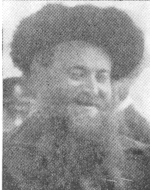Orenstein, Yitzhak-Avigdor
Son of-Shoshana-Reizel and Rabbi Moshe Yehuda-Leib, was born in Jerusalem in 1893. He studied in several yeshivas (Ohel Moshe, Torat Emet, etc.), and was one of the first to dream about the renewal of the country. One of the founders of the young company “The Hebrew Village”, whose main task was to establish villages and neighborhoods for the benefit of yeshiva students who would help establish the Land of Israel – especially the “Old Yishuv”. Bought the lands of the village of Beit Hanina as a plot for young people from Jerusalem who wanted to devote themselves to agricultural work. Until his last day he worked for the village. He was a member of its board and treasurer, He also took an active part in the redemption of land north-west of Jerusalem (near the Sanhedrin graves) on which the Sanhedria neighborhood was established, and Rabbi Yitzhak Avigdor published a journal called Dvir, a monthly of Torah and Jewish wisdom, He was also a delegate to two Zionist congresses (the thirteenth in Karlsbad and Tu B’Sel.) After the trial of the nations regarding our right to the Western Wall (in 1931), which allowed us to appoint a representative in charge of that part of The wall to which the approach was permitted was appointed by the national institutions and the Chief Rabbinate as an important and holy position – the position of the inspector at the Western Wall. For eighteen years he would work day by day and help the Jews who came to commune with the Western Wall. In 1938 he was appointed by the Admor of Lubavitch to head the Kollel Chabad in Israel and he did not fail to fulfill his duties: he was the father of hundreds of poor families in the Old Yishuv, his widows and orphans. “Who sat in shifts day and night in prayer for the poor brothers in the Diaspora. He was chairman of the “Union of the Sons of the Old City”, whose goal was to strengthen the Jewish community in the Old City; First of all, it was the foundation of an “escort fund” – and its assistance was felt mainly during the days of the siege; The Association also dealt with the redemption of Jewish homes that had been transferred to Arab ownership. At the beginning of the Arab siege of the Old City during the War of Independence, he was invited to the new Jerusalem in connection with the Kollel affair, but did not accept his friends’ pleas to stay with them, especially after he learned that his house had been blown up and his son injured. After much effort and lobbying by prominent figures, such as Yitzhak son of-Zvi and Rabbi Herzog, before the British authorities, he was allowed to return to the Old City. To his friend in the United States, who asked him why he had insisted on going down to the place of danger, he answered: “If someone is to be sacrificed for the sanctity of Jerusalem and its holy places, then I am obligated to do so by everyone else.” His house, which stood on the border between the Jewish Quarter and the Arab Quarter and served as a stand for the defenders, was completely destroyed and burned down on his large library and important manuscripts; But the rabbi did not give up. He immediately appeared in the ranks of the first defenders and was appointed administrative director of the residents of the quarter. During his three months in office, he demonstrated his ability to work arrangements, defense, the Hebrew police and encouragement of spirits in general, and in fact was responsible for all areas of life. Two days before his fall, he helped to bury the defenders of the Quarter who had fallen during the week, and he, as the father of the “old Yishuv,” said the last Kaddish on their grave. However, on the day after the Sabbath, on May 23, 1948, he was hit by an enemy bullet and even his rabbinical wife (Moshka-Liba) was wounded by mortal wounds. Both were brought to burial in the same place. He laid four boys and two girls. According to the decision of the Jerusalem Municipality, one of the streets in the Tel Arza neighborhood of the city is named after the rabbi. His name was engraved on the monument erected in the military cemetery on Mount Herzl in memory of those who died in the QuarterIndian and the memory of fighters who fell in battle for Jerusalem and were brought for burial on the Mount of Olives.
